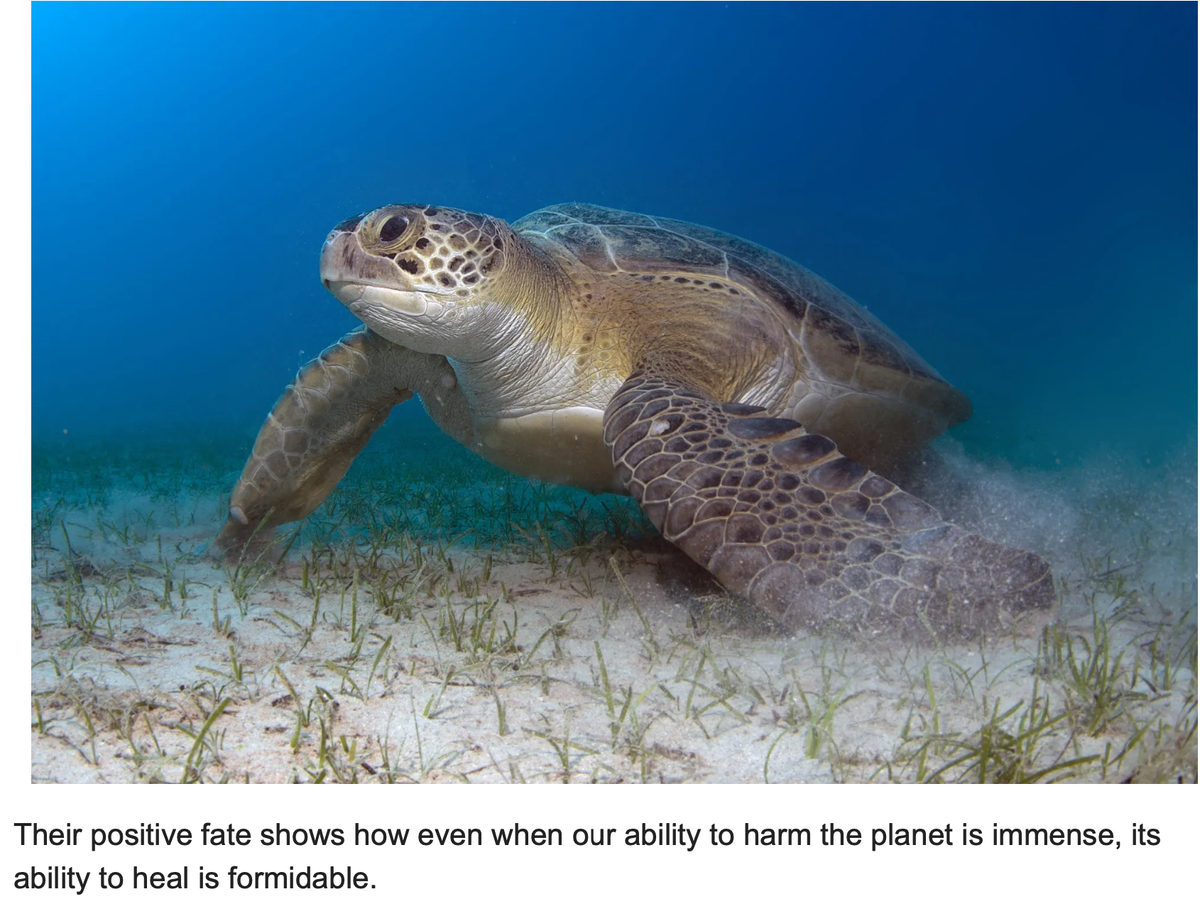The Green Page:

Sea Turtles Aren’t Vanishing - They’re Thriving:
It’s hard to forget your first glimpse of a turtle in its natural environment.
In my case, it happened about 15 years ago, on a cay in Australia’s Great Barrier Reef. Pulling on a head-to-toe nylon suit to protect against jellyfish stings and strapping on a snorkel, mask and fins, I swam lazily over a rainbow of coral and, within minutes, found myself surrounded. Close to a dozen hawksbills and green turtles were gliding silently over the reef, curious but untroubled by my presence. Skittish dolphins and seals may be smarter, but no sea animal will scrutinize you with quite the same relaxed intelligence you sense gazing into a turtle’s obsidian eye.
It’s no surprise, then, that they’ve become icons of the damage that we’re doing to our environment — a status they share with other charismatic species, like the humpback whale and polar bear. No fundraising leaflet, charity PDF or anguished news report about the state of the world’s oceans is complete without a turtle munching on a shopping bag or with a plastic straw sticking out of its nose. In a planet so obviously under threat, it seems self-evident that such a gentle and lumbering creature should be heading rapidly toward extinction.
Surprisingly, that’s not the case. Indeed, a growing body of studies in recent years has shown that thanks in part to decades of diligent conservation work, turtles are not just holding on — their populations are, in many cases, exploding.
Researchers led by Professor Graeme Hays of Deakin University in Melbourne this year compiled 61 datasets of nesting locations from around the world. They found just five sites where populations were declining. In 28, they were increasing — often dramatically.
Cabo Verde’s Sal Island, off the northwest coast of Africa, the number of loggerhead nests has increased to 35,000 in 2020 from 500 in 2008 — a 70-fold improvement. In Diego Garcia, a British territory in the Indian Ocean leased to a US naval base, a drone survey in 2021 found the highest densities of hawksbills anywhere on the planet.
In the Gulf of Mexico, the Kemp’s ridley — a breadboard-sized reptile that’s considered the most endangered sea turtle — has gone from 702 nests in 1985 to 17,000 in 2022. An analysis in 2023 discovered as many as 150,000 green turtle nests on three uninhabited reefs in the French Pacific territory of New Caledonia, an area that had previously been overlooked.
What explains the rebound?
My very first encounter with a turtle holds one clue — not that idyllic moment on the GreatBarrier Reef, but in the faded restaurant of a 1980s hotel in Scarborough, England, gazing down with a child’s natural distaste at a bowl of consommé with a few gelatinous lumps floating in it.
Turtle soup, which appears to have originated when 18th-century British colonists in the Caribbean adapted Indigenous recipes to keep up their protein levels, became a coveted delicacy in Regency Britain. The animals were hunted close to extinction, and the Victorians devised an imitation version made from calf’s head as an alternative —the inspiration for Lewis Carroll’s glum Mock Turtle in Alice’s Adventures in Wonderland.
It’s probably this mock turtle soup I ate as a child — though it’s hard to be 100% certain, as there’s still a turtle farm on the UK dependency of the Cayman Islands and even today, you’ll find its meat on the menu of local restaurants1. That’s a bizarre local anomaly these days, however. In most parts of the world, eating turtle soup is about as de rigueur as flaunting a panda-fur stole.
Taking human stomachs out of the equation has probably made life easier. For all their low-witted appearance, turtles are supremely well-adapted to their environment. Armored shells are arguably the animal kingdom’s earliest and most effective defence mechanism. By one estimate, you need to be about 200 times heavier than a turtle to chomp its shell open. Though sharks and crocodiles have been observed eating them, that bite-to-weight ratio means fully grown turtles have few natural predators.
Since turtle conservation took off in the 1970s. Moreover, humans have, in many cases, turned from aggressors into protectors. A 1975 treaty banning trade in endangered species shut down global commerce in meat, shells and leather. Hundreds of thousands of volunteers fan out each year across beaches on six continents to count nests and the tracks that mothers and hatchlings leave on the sand. Local regulations ban night-time lighting near rookeries, which can confuse hatchlings who navigate to the waves by following the light of the moon. Shrimp nets in many parts of the world must carry special devices to allow reptiles to escape the trawl unharmed.
The effectiveness of these regulations highlights the problems faced by the one species where we’re conspicuously failing — the leatherback, a behemoth as long and almost as heavy as a Smart microcar.
“They're a real hard nut to crack because they continually wander the oceans foraging for jellyfish,” says Deakin’s Hays. “You can't just have a small focal area for protection.”
With other species, it’s generally sufficient to impose local rules on beaches and fisheries to allow populations to rebound. Leatherbacks’ tendency to travel vast distances means rules the need to be global — something that any climate diplomat would recognise as an almost insurmountable impediment. They regularly drown after becoming caught up in fishing tackle, abandoned nets or stray pieces of synthetic rope. Four of the 16 studies cited by Hays showed leatherback populations declining. At one site in Costa Rica, nest numbers fell from 1,500 in 1988 to 15 in 2018.
Turtles may also be benefiting from our heedlessness about protecting fewer adorable denizens of marine ecosystems. Populations of sharks have fallen 71% globally since 1970, meaning fewer predators to suppress numbers of juveniles and adolescents. Some threats to the environment may provide temporary benefits to sea turtles: Warmer and more acidic oceans due to climate change are likely to lead to less coral and more sponges, seagrass and jellyfish, some of their favourite foods.
Still, at a time when the prospects that we can turn back the tide on environmental destruction seem bleak, it’s worth reflecting on the surprisingly positive fate of the sea turtle. Once we stop doing damage to ecosystems, recovery can be remarkably quick. Our ability to harm the planet is immense — but its ability to heal is formidable, too.

